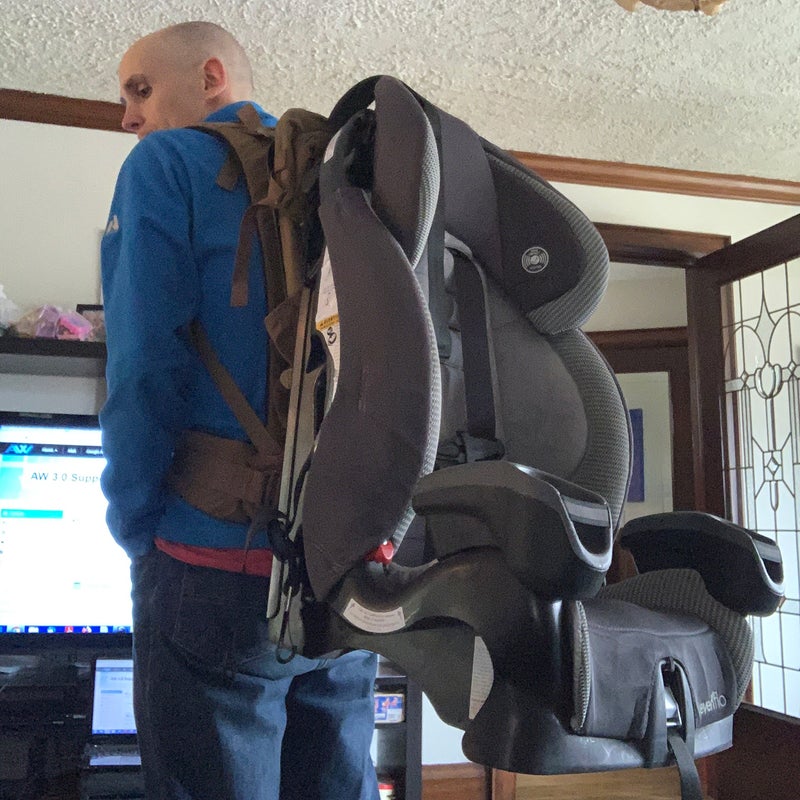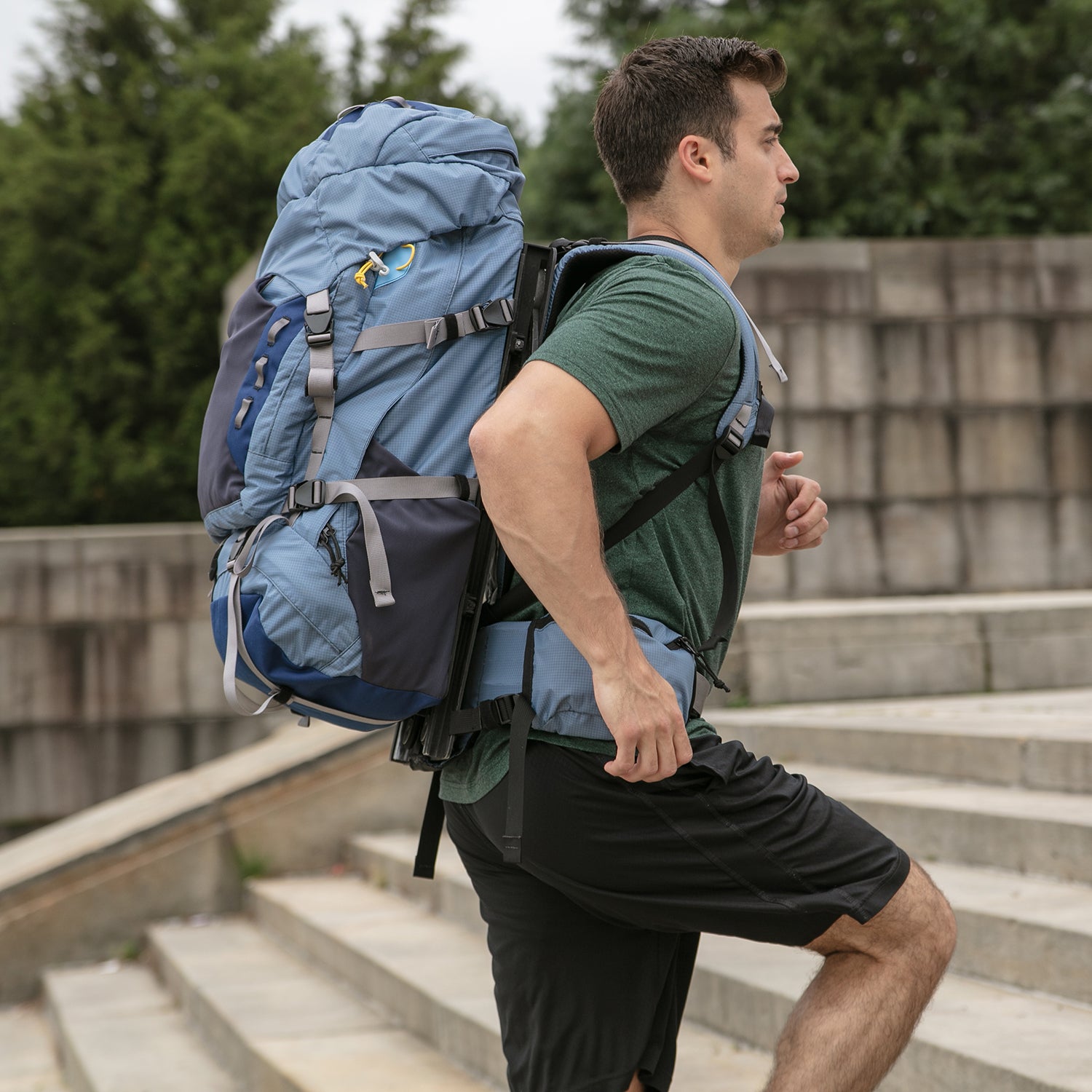Back in April, when the pandemic was young, I dropped my car off at the garage to switch out my winter tires. Then, as usual, I ran the two and a half miles home. My plan was to hike back that afternoon with my four- and six-year-old kids, who I’d be watching for the rest of the day thanks to the cancellation of school. The flaw in the plan, which I discovered when I returned home, was that I’d forgotten to reinstall my four-year-old’s car seat after taking it out to give someone a ride.
The car seat is one of those bulky behemoths, apparently designed to protect my kid until she leaves for university. According to the manufacturer’s specs, it weighs 21 pounds. This was at the absolute pinnacle of the pandemic in Ontario, where I live. Public transit was out, as were taxis and car shares. So I decided to unpack an unmarked cardboard box that had been sitting in my study for a few days, waiting for its moment.
In October 2018, I wrote about a Kickstarter campaign launched by a company called Lightning Packs to produce the “world’s first floating backpack.” The is connected to its frame by a pair of tensioned bungee cords that allow it to slide up and down on your back. The idea is that, as you bounce up and down while walking or running, the pack itself stays nearly stationary, reducing the vertical forces on your body by more than 80 percent and conserving energy. looked almost Photoshopped, and the story of its yearslong, military-funded development by University of Pennsylvania professor Larry Rome, starting way back in 2002, was fascinating. But as a consumer product, it was still only hypothetical at that point.
Then, in March of this year, I got an email from Rome. The company had missed its initial target shipping date—not a big surprise for a Kickstarter product, but the reasons for the delay were fairly epic. The cloth designer’s studio, in Paradise, California, had burned to the ground in the Camp Fire in late 2018. Then Rome had open-heart surgery. Then, just when a key component of the pack frame was ready to ship from China, the coronavirus hit. Eventually the component made it to the U.S., where the packs are assembled—and now Rome was offering me the chance to try one out.
As I’ve written elsewhere, I’m not much of a product reviewer. I’m most comfortable writing about how things work and analyzing the evidence for their effectiveness, rather than giving my subjective take. But occasionally, I can’t resist taking a new product for a spin. And as an enthusiastic backpacker, a magic energy-saving backpack was too good an opportunity to pass up.
So that’s what I unboxed in April. The HoverGlide comes in : a big 55-liter model for multi-day trekking and three 30-liter variants dubbed the Tactical, the Hiker, and the Commuter. I’ve got the Tactical, which is optimized for hauling loads of up to 25 pounds on long runs and rugged hikes.
The first thing I pulled out of the box was a fairly detailed instruction sheet, along with a postcard-size cheat sheet explaining how to “unlock” the pack (so it could float on the bungees), “lock” it (giving it a rigid connection to the frame, so it acted like a normal pack), adjust tension in the bungees, and take apart the frame. I didn’t have time to fuss around with any of these details: I unlocked the pack, clipped the car seat to one of the many loops and straps dangling from the pack, and headed out with my kids.

My first impression was that the pack is really heavy, even in its unloaded state. Rome tells me that its weight is seven pounds, and it certainly felt heavier than any comparable empty backpack I’ve ever worn. But once it was in place, setting off with the car seat felt remarkably comfortable. Clearly the pack was not designed to have a car seat strapped to it—but it worked. Here’s a clip of me walking with the pack (excuse the slightly shaky camerawork by my six-year-old):
Admittedly, it’s tricky to figure out exactly what’s happening there. Sometimes it looks like the pack is floating along in a straight line and I’m bouncing up and down; other times it looks like the pack is bouncing and I’m smooth, though that may just be an optical illusion. Subjectively, it felt comfortable and well synced, as though the pack was sliding up when I was coming down and vice versa. The exception: sometimes if I stumbled or broke stride, the pack and I would end up moving in the same direction for a step or two, which was awkward.
The other occasional problem was that the pack would bounce so high on the upswing that it would slam into the top of the frame with each stride. I knew this meant the bungees had too much tension, but I hadn’t read the instructions thoroughly enough to figure out how to change it, and the control lever, tucked on the lower right of the pack, wasn’t intuitive enough to fake it.
The next time I took the pack out, I was better prepared. For a hike with the family, I loaded it up with water bottles and snacks and more water bottles. This time I’d figured out how to add and release tension on the fly. Too much tension, and the load would smack into the top of the frame. Too little, and it would bottom out with each stride. Knowing this allowed me to find the sweet spot where it would oscillate freely without hitting the frame.
But the most telling adjustment happened when I disabled the suspension, using another lever on the lower right of the pack. For the most part, wearing the pack felt reasonably comfortable but not mind-blowing. I wasn’t hiking along thinking, Wow, it feels like I have nothing on my back. But as soon as I locked the suspension, I realized how much the load had previously been lightened. The difference was instantly and impressively noticeable. There’s no doubt that the mechanism really works.
I discovered the other big difference when I tried running with it. The load of water bottles and other gear, which probably added up to 15 to 20 pounds, was heavy enough that I wouldn’t be at all comfortable running with the pack under normal circumstances. But with the suspension activated, it was doable. Here’s a clip of me running; toward the end of the video, you can see that I’m getting the rhythm right, and the pack basically stops moving up and down relative to the ground:
There’s one big catch to all this. It’s now August, and I haven’t actually used the pack much over the summer. That’s not because I don’t think it works or don’t think it’s cool. It’s just that it doesn’t fill any particular gap in my current pack needs (at least as long as I remember to leave the kids’ car seats installed). When I go for a day hike with my kids, I might carry six or seven pounds of supplies. To me, it feels easier to carry that in an ultralight pack than to double the weight in order to get the benefits of a frame and suspension. Later this month, when I head out on a multi-day backpacking trip, I’ll be carrying an 80-liter pack, and even that will be a tight fit. So for me, the small 30-liter packs aren’t small enough, and the big 55-liter pack isn’t big enough.
Of course, others have different needs, and my own needs may evolve. I could imagine using something like this to backpack around Europe while staying in huts or hostels, or for a fastpacking trip with a substantial amount of slow running. My HoverGlide seems to be extremely rugged and durable, which is a plus. But I wonder if, with a little more product development, the weight of the pack could be cut in half. That’s a trade-off I’d accept, even if it cost some durability.
If you’re interested in checking it out yourself, the smaller packs are now for $499, and the big pack can be preordered for $599 for estimated delivery in April 2021.
For more Sweat Science, join me on and , sign up for the , and check out my book .


